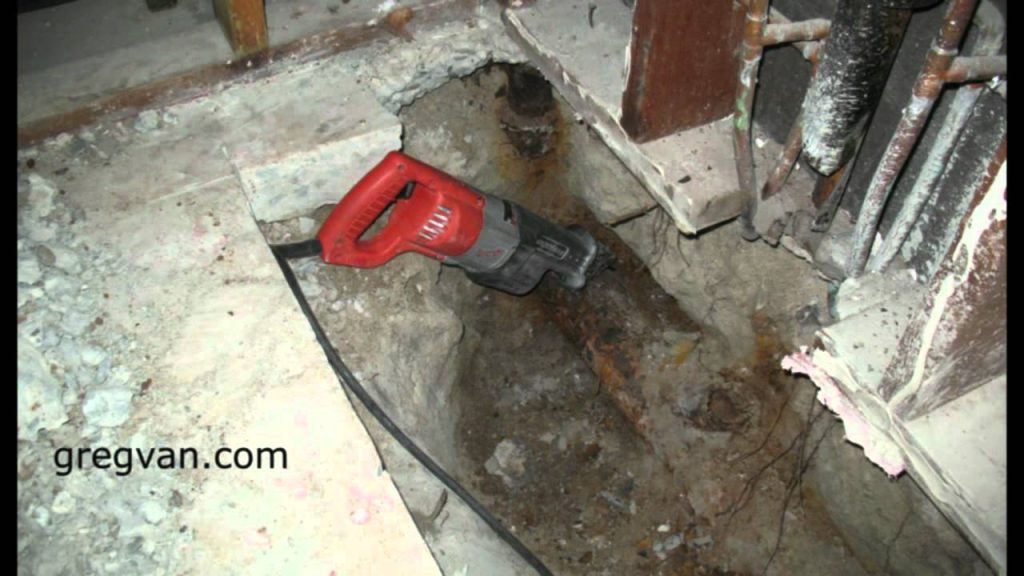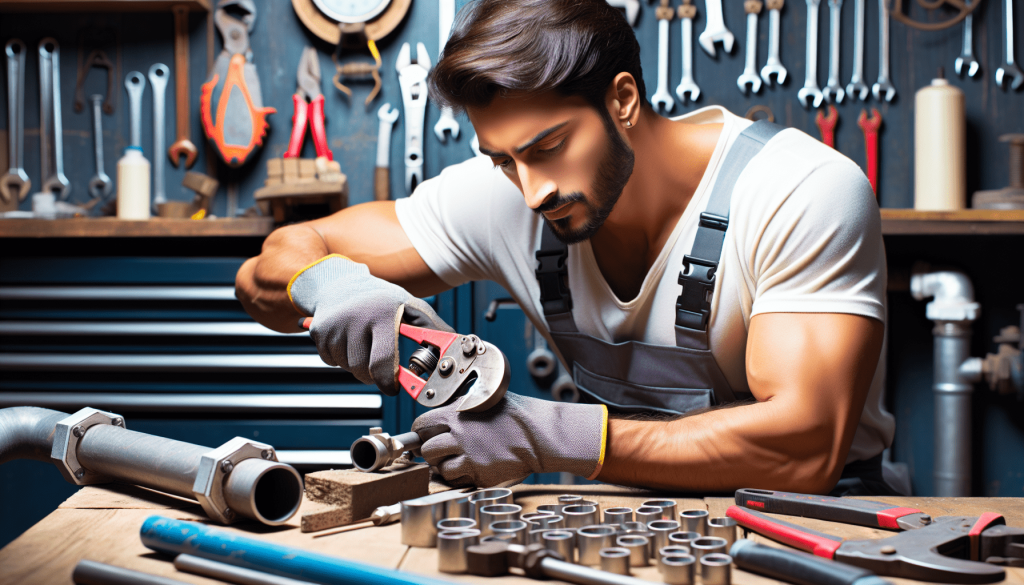Thinking about cutting cast iron pipes for a plumbing or home remodeling project? Well, we’ve got some tips for you! In a video by gregvancom, he explains that while it is possible to cut a cast iron pipe with a regular metal blade on a saw, it may take a few blades to get through. If you have a special cast-iron sawzall blade, you can give that a try, but the good news is, a regular bi-metal blade for cutting metal will do the trick. Just keep in mind that the biggest challenge you’ll face is the dirt surrounding the pipe. If it’s in the ground, make sure to clear away as much dirt as possible to prevent your saw blades from getting ruined faster. And most importantly, safety first! These pipes carry water, so before you start cutting, make sure to allow any water to flow out of the pipe and get it out of the hole. No one wants to get electrocuted, right? So, remember, with the right tools and precautions, you can successfully cut cast iron pipes for your project.

Choosing the Right Tools
Using a saw with a metal blade
When it comes to cutting cast iron pipes, using a saw with a metal blade is crucial. The strength and durability of a metal blade make it the ideal choice for this task. It can easily cut through the tough and rigid material of cast iron, ensuring a clean and efficient cut.
Consider using a special cast-iron sawzall blade
While a regular metal blade can get the job done, it is worth considering using a special cast-iron sawzall blade if one is available. These blades are specifically designed for cutting through cast iron and may offer better performance and longevity compared to a regular metal blade. It is always beneficial to explore specialized tools that can enhance the efficiency of the cutting process.
Using a regular bi-metal blade for cutting metal
If a special cast-iron sawzall blade is not readily accessible, a regular bi-metal blade can also be used for cutting cast iron pipes. Bi-metal blades are designed to handle various types of metal, including cast iron. While they may not be as effective as a specialized blade, they can still provide satisfactory results. It is important to ensure that the blade is sharp and in good condition before proceeding with the cutting process.
Preparing the Work Area
Clearing dirt around the pipe
One of the essential steps in cutting cast iron pipes is clearing the dirt around the pipe. This is particularly crucial if the pipe is located underground. Accumulated dirt can cause unnecessary damage to the saw blade and hamper the cutting process. By clearing as much dirt as possible, we can ensure a smoother and more efficient cutting experience.
Ensuring the pipe is above ground to avoid dirt issues
If the pipe is above ground, we can avoid potential issues related to dirt and soil. This saves us from the hassle of clearing dirt and ensures a cleaner work area. It is always advantageous to work with pipes that are easily accessible, as it simplifies the cutting process and minimizes any complications that may arise.
Removing as much dirt as possible to prevent blade damage
Even if the pipe is above ground, it is still important to remove any dirt or debris present around the pipe. This prevents the accumulation of dirt during the cutting process, which can potentially damage the saw blade. By taking the time to remove as much dirt as possible, we can prolong the lifespan of our tools and achieve more precise cuts.
Ensuring Safety
Allowing water to flow out of the pipe before cutting
Before cutting a cast iron pipe, it is essential to let any water inside the pipe flow out. Failure to do so can result in water leakage and potentially lead to accidents. By ensuring that the water is completely drained from the pipe, we can minimize any potential hazards and work in a safer environment.
Preventing the risk of electrocution
Working with pipes, especially water pipes, entails the risk of electrocution. It is crucial to exercise caution and take necessary precautions to avoid this danger. Even if a powered tool has rubber insulation, it is still vital to be wary of the possibility of electrical hazards. Never underestimate the potential for accidents and always prioritize safety.
Being cautious of powered tools with rubber insulation
While tools with rubber insulation provide some level of protection, it is important not to solely rely on it. Rubber insulation can deteriorate over time, rendering it ineffective. Thus, it is crucial to exercise caution when using powered tools, ensuring proper grounding and avoiding any unnecessary risks.
Cutting Techniques
Using a saw saw and metal blade
To cut cast iron pipes, a saw with a metal blade is the primary tool of choice. It is important to secure the pipe in a suitable position that allows easy access. Gripping the saw firmly, we can make the necessary cuts with precision and control. Always prioritize safety and maintain a steady grip on the saw while cutting.
Applying steady pressure while cutting
When cutting through a cast iron pipe, it is important to apply steady and consistent pressure. This ensures a smooth and even cut. Avoid exerting excessive force, as this may lead to pipe damage or compromised cutting accuracy. By maintaining a steady pace and pressure, we can achieve cleaner cuts and minimize the risk of accidents.
Being patient as multiple blades may be needed
Cutting cast iron pipes can be a time-consuming process, and it is essential to be patient. The hardness and toughness of cast iron can cause blades to wear out faster. Therefore, it is quite common to require multiple blades to complete the task. When a blade becomes dull or ineffective, it’s necessary to replace it promptly to ensure optimal cutting performance.
Taking breaks to allow the blade to cool down
During the cutting process, the blade can generate significant heat. Excessive heat can affect the performance and lifespan of the blade. To prevent overheating and extend the longevity of the blade, it is advisable to take short breaks during the cutting process. This allows the blade to cool down and ensures that it remains in optimal condition.

Dealing with Larger Pipes
Considering the use of a reciprocating saw
For larger cast iron pipes or more complex projects, a reciprocating saw may be a suitable alternative. These powerful tools offer greater cutting efficiency and can handle larger pipe diameters. It is essential to assess the scale and requirements of the project to determine if a reciprocating saw is necessary.
Using more powerful tools when necessary
When dealing with larger or more challenging pipe cutting tasks, it may be necessary to utilize more powerful tools. Industrial-grade cutters or specialized equipment can provide the necessary strength and precision to tackle these projects. However, it is important to ensure proper training and expertise in handling these tools to avoid accidents and damage.
Seeking help from professionals for larger and more complex projects
For particularly large and complex projects involving cast iron pipe cutting, it is advisable to seek assistance from professionals. Experienced plumbers or contractors have the knowledge, expertise, and specialized tools to handle such tasks efficiently and safely. Remember, it is always better to seek professional help when in doubt or when dealing with extensive projects.
Minimizing Dust and Debris
Wearing appropriate safety gear, including goggles and masks
While cutting cast iron pipes, it is essential to prioritize personal safety. Wearing appropriate safety gear, such as goggles and masks or respirators, is crucial to minimize exposure to dust and debris. This protects our eyes and respiratory system from potential harm and ensures a healthier working environment.
Covering surrounding areas to prevent contamination
To minimize the spread of dust and debris, it is wise to cover the surrounding areas. Using plastic sheets or tarps can effectively contain the particles and prevent contamination in the surrounding environment. Taking this precautionary step saves time on post-cutting cleanup and promotes a tidier work area.
Using a wet/dry vacuum to remove dust and debris
To maintain cleanliness during and after the cutting process, it is beneficial to use a wet/dry vacuum. This powerful tool can effectively eliminate the dust and debris generated during cutting. By promptly removing the particles, we can ensure a safer and more organized workspace.

Proper Pipe Support
Ensuring the pipe is adequately supported before cutting
Before commencing with the cutting process, it is crucial to ensure that the pipe is adequately supported. Unstable or unsupported pipes can lead to accidents and damage. By providing proper support, such as clamps or braces, we can minimize movement and maintain stability, enabling a more controlled and precise cutting experience.
Using clamps or braces to prevent movement
Using clamps or braces is an effective method to prevent pipe movement during the cutting process. These tools securely hold the pipe in place, allowing us to focus on the cutting technique without worrying about unwanted shifts or vibrations. Properly securing the pipe ensures accurate cuts and reduces the risk of injury.
Avoiding excessive force or pressure that can damage the pipe
When working with cast iron pipes, it is essential to handle them with care. Applying excessive force or pressure can lead to pipe damage or even breakage. It is crucial to strike a balance between the necessary force for cutting and the preservation of the pipe’s integrity. By exercising caution and using controlled force, we can prevent unnecessary damage and ensure smooth cuts.
Post-Cutting Cleanup
Removing any remaining debris from the cut
After completing the cutting process, it is important to remove any remaining debris from the cut area. This can be accomplished using a brush or cloth to wipe away loose particles. Clearing the debris enhances the overall appearance of the cut and ensures a cleaner and safer environment.
Inspecting the cut edges for smoothness and accuracy
Inspecting the cut edges is an important step to ensure the quality of the cut. Smooth and accurate edges indicate a job well done. By closely examining the cut, we can identify any imperfections or irregularities that may require further attention. It is essential to correct any issues to prevent future complications or leaks.
Applying a rust inhibitor to prevent corrosion
Due to the nature of cast iron, it is susceptible to corrosion. To protect the freshly cut edges and prevent rust formation, it is advisable to apply a rust inhibitor or protective coating. This simple step helps prolong the life of the pipes and ensures that they remain in optimal condition for an extended period.

Proper Disposal of Removed Pipe
Following local regulations for disposal
When it comes to disposing of removed pipe material, it is important to adhere to local regulations. Various regions have specific guidelines and recycling programs in place for metal waste, including cast iron pipes. It is essential to familiarize oneself with these regulations to ensure proper disposal and environmental responsibility.
Considering recycling options for cast-iron pipes
Cast iron is a recyclable material, and recycling options for cast-iron pipes are available in many areas. These pipes can be repurposed and used in various industries, minimizing waste and reducing the environmental impact. Consider reaching out to recycling facilities or scrap metal yards to explore recycling opportunities for cast iron pipes.
Contacting local waste management authorities for guidance
If unsure about the proper disposal method for removed cast iron pipes, it is advisable to contact local waste management authorities. They can provide accurate guidance based on the specific regulations and recommendations in the area. By seeking professional advice, we ensure that we dispose of the pipes responsibly and in compliance with the law.
Conclusion
Cutting cast iron pipes can seem like a daunting task, but with the right tools, techniques, and precautions, it can be accomplished efficiently and safely. Choosing the appropriate tools, such as a saw with a metal blade, makes a significant difference in achieving clean and precise cuts. Clearing the work area of dirt, ensuring safety measures are in place, and applying steady cutting techniques are essential steps to minimize risks.
When dealing with larger or more complex projects, it may be necessary to consider using more powerful tools or seeking professional assistance. By prioritizing safety and taking necessary precautions, we can successfully handle any cutting challenges that come our way.
Furthermore, minimizing dust and debris, properly supporting the pipe, and ensuring post-cutting cleanup are essential for a tidy and organized work environment. Responsible disposal of removed pipe material, whether through recycling or following local regulations, is crucial to reduce waste and protect the environment.
Remember, cutting cast iron pipes requires patience, attention to detail, and proper safety measures. Whether it’s a small household project or a more extensive remodeling endeavor, the key is to approach it with the right tools, knowledge, and precautions. By doing so, we can ensure a successful and efficient cutting experience while maintaining personal safety and the integrity of the pipes.


